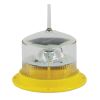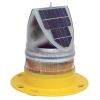Sealite SL-60 2-3NM+ Solar Marine Light
The Sealite SL-60 solar marine light features a 2-3 nautical mile visible range.
Features
- 4 user adjustable intensity settings
- 6 ultra high intensity LEDs
- 3 year fix or replace warranty
- Free ground shipping
- Expedited repair and warranty service
- Lifetime technical support
- More
Overview
The Sealite SL-60 is the most popular and versatile solar marine light available. Made from tough, durable polycarbonate and using the latest high-intensity LEDs, no expense has been spared in the design and development of this lantern. The SL-60 can be installed in minutes and requires no operator intervention. The Sl-60 comes with an environment-friendly bird deterrent built in to prevent damage to the device.
Adjustable
The user easily adjusts the flash sequences on site, and the lantern has a permanent ON/OFF switch for easy storage. The solar module will charge the battery during daylight hours, and the lantern will automatically begin operation at dusk.
Battery-Powered.
The SL-60 features a sealed battery compartment, allowing the battery to be replaced after years of service. Don't throw the light away at the end of the battery service life. Life expectancy of up to 12 years with battery replacement approximately every 5 years. The unit is sealed using polycarbonate bonding compounds similar to those used by major automobile manufacturing companies.
- Light Characteristics
- Light Source: 6 ultra-high intensity LEDs
- Range: 2 nautical miles
- Flash Color: Red, White, Yellow, Blue, Green
- Intensity:> 8.3cd
- Horizontal Output (degrees): 360 degrees
- Vertical Divergence: 9 degrees
- Flash Settings: Up to 256 IALA recommended (user adjustable)
- Lamp Life: 100,000 hours
- Electrical Characteristics
- Current Draw: Minimal
- Circuit Protection: Integrated
- Operating Voltage: 3.6v
- Autonomy:> 20 days (14 hour darkness, 12.5% duty cycle)
- Solar Module Type: Multicrystalline
- Output: 1.4watt
- Battery Type: High grade NiMH -replaceable
- Battery Capacity: 4Ah
- Battery Voltage: 3.6v
- Physical Characteristics
- Body Material: LEXAN Polycarbonate - UV stabilized
- Lens Material: LEXAN Polycarbonate - UV stabilized
- Mounting: 4x4.5mm mounting holes
- Height: 20.5cm
- Width: 17.7cm
- Mass: 1.1kg
- Certifications
- CE: EN61000-6-3:1997, EN61000-6-1:1997
- Quality Assurance: ISO9001:2000
- Waterproof: IP68
- Patents: US Pat. No. 6,667,582. AU Pat. No. 778,918
- Trademark: BargeSafe is a registered trademark of Sealite Pty Ltd
- Warranty: 3 years
In The News
Sustainable Fishing in Alaska: Protecting the Salmon Capital of the World through Research
In the far north, the Alaska Peninsula stretches away from the Last Frontier into the Pacific Ocean. A narrow strip of land dotted with freshwater lakes and intruded upon by ocean inlets–this unique region is intimately connected with the surrounding water. Nestled halfway down the peninsula's southern coast are the small villages of Chignik. The area has historically been home to the Aleut people and has been heavily reliant on fishing for centuries. Home to commercial and subsistence fishing today, Chignik continues to rely upon the salmon returns to the surrounding villages, which are supported by scientists working tirelessly to understand and steward these fish populations.
Read MoreNexSens X3 Data Logger Review
Extreme environments meet extreme design with the NexSens X3 Data Logger . The new logger offers the latest in real-time monitoring technology with wireless communication, a large plug-and-play sensor library and ultra-low power consumption, all in a waterproof marine-grade housing. The X3 is built to handle harsh weather, floods, high winds and rough seas, and it stands alone; no additional protective housing needed. With an operating temperature that ranges from -40°C to 70°C, the logger can withstand arctic environments and extreme heat. A conformal coating on the internal circuit board isolates it from moisture and humidity.
Read MoreBuoy-Based Solutions: Strengthening Kentucky’s Emergency Response Efforts
When Kentucky’s Emergency Response Team (ERT) has to act quickly in response to chemical and oil spills in the Commonwealth, they rely on small, easily deployable buoys to collect critical data that help minimize and evaluate damages in environmental emergencies. With a background in geology, Robert Blair primarily worked with groundwater and got involved sporadically with the ERT during groundwater contamination emergencies. Over time, this involvement led to him joining the ERT as an On-Scene Coordinator and then becoming the branch manager for the team and overall Emergency Response Branch .
Read More
















